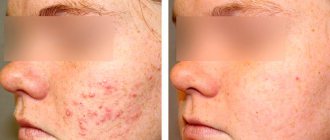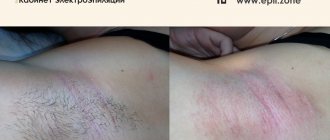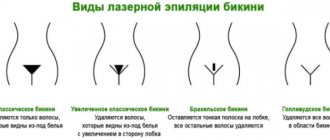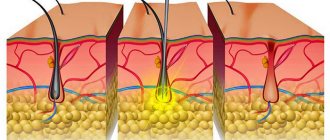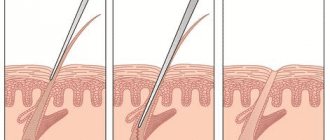What skin condition after electrolysis is considered normal?
Almost all girls who have undergone electrolysis for the first time are faced with a very real problem - redness, scabs and scratches. And okay, if it comes to legs that can be hidden or the bikini area. But what to do with the face? Is it really possible to avoid skin trauma with such a fairly aggressive method of hair removal as electrolysis?
The fact is that electrolysis is a controlled traumatization. Yes, any hair removal aimed primarily at irritation. And it is almost impossible not to touch areas of the skin. However, you may encounter real problems, and it will take quite a long time to treat and restore the skin.
The condition of the skin will depend on the following factors:
- Zone. Naturally, in some areas the skin is much more delicate, so the procedure can affect it much more. So, say, on the face, when removing the antennae, the redness may be much stronger than on the lower leg.
- Regeneration. And this is a personal feature for everyone. Indeed, one client of a salon where electrolysis is performed may get away with slight redness, while another may get away with irritation, scratches and scabs.
- Electrolysis and its types. Electrolysis is a more delicate method than thermolysis and blending. The likelihood that the skin will be in better condition after electrolysis is much higher.
- Duration of the session. The skin reaction will directly depend on the time of application. The longer it takes, the more irritated the skin will be.
- Season and climate. The hotter it is, the more likely it is that irritation will occur and the skin will regenerate more slowly.
- Care. After electrolysis, you should definitely follow the recommendations of a cosmetologist, which will allow you to get your skin in order much faster.
So, what is normal and what is not? You need to know about this in order to quickly distinguish complications and begin the necessary therapy.
The following is considered normal after electrolysis:
- Slight redness is considered normal due to the fact that the injured area needs restoration, and this requires blood flow;
- Complete absence of hair - yes, electrolysis is one of the most effective procedures, and the likelihood that hair will never appear again is very high;
- Slight itching - this can also be considered normal, due to blood flow or even the occurrence of a slight allergy;
- Swelling after electrolysis is a reaction of blood vessels to blood flow, which is also considered normal after such a procedure;
- Small bruises - of course, this sign can be caused by the caretaker of the technician, but small bruises are not a big problem and should not be alarmed;
But the following signs should cause concern:
- Crusts after electrolysis – in some cases may be considered normal, but it is better to consult a doctor;
- Severe itching and the appearance of blisters is most likely an allergy, so it is better not to hesitate at all and call an ambulance;
- Scars after electrolysis - the skin can be replaced by fibrous tissue, and this may be due to both a personal reaction and the unprofessionalism of the doctor. In such cases, it is also important to consult a doctor;
- Pigmentation disturbance is a factor that should also cause concern and immediate contact with a dermatologist; Burns after electrolysis – speaks of the unprofessionalism of the cosmetologist;
- Herpes - everything is clear here, most likely an unscrupulous master brought the infection;
- Pigmentation after electrolysis also indicates that the doctor did something wrong.
One of many complications can be avoided with proper care. And below we will analyze general, but very important recommendations for proper care.
"Pitfalls" of electrolysis
Unlike conscientious doctors, unscrupulous ones still impose electrolysis services on their clients. This is understandable and understandable from the point of view of income - devices for electrolysis are cheap and accessible, they practically do not change or are modernized over time, so there is no need to regularly replace them.
The equipment itself, unlike lasers, is simple and primitive to use, which also reduces costs for owners of clinics and beauty salons.
Finally, working with a laser requires certain knowledge and advanced training, while even a recent graduate of a medical university can work with an electrical device.
A modern alternative to electrolysis is laser hair removal using modern devices. Check out our CANDELA GentleLase Pro Alexandrite unit!
How does the electrolysis procedure work:
- The device is configured;
- A nozzle with a microneedle-electrode is inserted into the follicle area, after which the device delivers an electric current to it;
- The hair follicle burns and dies, and the surrounding tissue is partially damaged.
The first, main and fair stone in the garden of electrolysis is the contact and invasiveness of the procedure . While the entire civilized world has long been using non-contact laser methods for hair removal, someone still moves needles across the skin to draw a spark to the bulb. Based on this, a natural and logical conclusion about the unsterility and unsafety of the procedure can be made even by a person who is very far from medicine.
The second argument against electrolysis is damage to surrounding tissue . It is this phenomenon that provokes the formation of microscars and microscars in the electrical burn area. Despite the prefix “micro”, any scars and cicatrices violate the aesthetics of the skin, making its texture rough and its shade uneven. And if scar changes in the armpits can still be tolerated, what should you do if scars from electrical burns remain on your face in the upper lip area?
An example of delayed skin hypopigmentation after exposure to an electrode
The third reason to refuse electrolysis is the severe pain of the procedure . Some cosmetologists jokingly call electrolysis voluntary masochism, and this is quite justified - even the highest quality anesthesia eliminates the pain from the procedure by only 30%. Added to this is a “bonus” torture - during electrolysis, each hair is processed separately, and the whole process is much more uncomfortable than if you plucked the hairs with tweezers.
One full session is usually divided into mini-sessions of 15-20 minutes, so as not to force the patient to endure pain. And even the most desperate and courageous people have long been hesitant to perform electrolysis without pain relief.
And finally, a very long time . For comparison, the time for epilation of the bikini area with laser devices varies from 10 to 20 minutes; with electrolysis you will spend at least 40 with a cosmetologist.
Skin care at home
Naturally, few people will be able to go to the salon every day after a session. Therefore, care will most often be at home. But there is nothing complicated about it. Often, care after electrolysis differs little from everyday care, but you will still need to abstain from some home procedures for the first time.
How to care for 1-2 days after the session?
The first day you will have to go without a shower. Or rather, do not wet the area of skin that was treated. And in general, for the first few days, refrain from any contact with the treated area of skin. This also applies to any perfume. You should not take a hot bath or go to the sauna or bathhouse in the first three days after the procedure. Refrain from exposure to direct sunlight, naturally no solariums. If swelling occurs, ice compresses can be applied.
Also, if there is severe redness or itching, you should never scratch the skin. It is better to take antihistamines.
If the procedure took place on the face area, then also refrain from using decorative cosmetics for the first 3 days.
If moisture does get in after electrolysis, the best treatment will be recommended by the doctor. However, it is possible to apply an alcohol tincture to the skin area and sprinkle with talcum powder.
How to care for days 3-6?
The next period, namely 3-6 days, you can begin gradual care. For this you will need antiseptics. The skin will need to be wiped regularly. Treatment will help avoid infections and problems in the future. It is better to consult a doctor about what antiseptics to use and on what schedule to treat the skin.
Sunbathing will still be strictly prohibited. Any physical activity and sports are undesirable. Firstly, it can cause increased sweating and, as a result, irritation. Swimming pools, saunas, and beaches are also still prohibited, especially if there are minor electrical hair removal burns. It is also not recommended to peel off the resulting crusts. In general, you should treat your skin with the utmost care and not even touch it with particularly dirty hands.
Care after the 7th day
If a week has passed after the procedure, then you can gradually return to normal life. For now, it is still not advisable to use scrubs and other exfoliating treatments. However, you will be able to use your usual skincare products.
If there are no side effects, rashes, crusts, allergies, then after the 7th day you can gradually go to the beach and even sunbathe a little. The skin will still need to be treated with products prescribed by the doctor. These can be antiseptics, as well as products based on panthenol or zinc ointment. If irritation appears on the skin a week after electrolysis, it is better to consult a doctor.
Important! If crusts appear, do not peel them off under any circumstances. You should wait until they fall off on their own.
Myths about electrolysis
People who are accustomed to making money from electrolysis give a lot of surprising arguments in its favor. Let's look at the most popular of them.
Electrolysis is the only way to permanently remove hair
And the laser only affects dark hairs, which cosmetologists are silent about.
Indeed, the first lasers to appear in aesthetic medicine affected only melanin. But what is the point in remembering outdated equipment when any decent cosmetologist now has IV-V generation lasers in their arsenal, which work perfectly even on dark skin and light hair?
As for the loud “forever”, the point is controversial. Yes, scar changes prevent hair regrowth from a physiological point of view, but does every cosmetologist have such a strong intuition to use a microneedle to influence all follicles located in the surgical field, including those in the catagen and telogen phases?
And the main question is - what exactly is the advantage here over a laser, which, with a professional approach, also removes hair forever?
Electrolysis is a cheaper method of hair removal.
But wax is even cheaper!
The cost of hair removal procedures varies depending on the status of the clinics, region, size of the city and other factors. It is possible that one session of electrolysis is on average cheaper than one session of laser hair removal. But what happens in the end: in the second case, the hairs are eliminated quickly and safely, literally in 3-4 sessions, and in the first case you will have to attend 5-6 sessions even to eliminate vellus hair in the upper lip area. That is, laser and electrolysis, performed in a certified clinic, practically do not differ from each other in cost.
As for the tempting offers from cosmetologists working in dubious private offices or at home, a course of electrolysis will cost much less from a financial point of view and much more from a health point of view.
Electrolysis does not harm the skin, laser does.
This myth does not even need verbal debunking. It is enough to look at the photographs that the doctors themselves show immediately after the session to understand the scale of the misconception. Severe swelling and redness indicate serious damage to the deep structures of the skin - this is the body’s natural reaction to burns of any etiology.
A burn causes tissue scarring, which can adversely affect the appearance and functioning of the skin later. For hypersensitive skin, red spots, irritation and swelling do not go away within 1-1.5 months after the procedure.
Electrolysis removes hair quickly - in just 3 sessions, taking into account the growth phases.
As practice shows, before complete hair removal, 85% of patients attend electrolysis sessions for 1-2 years. While the alexandrite laser is guaranteed to remove all hairs in 3-6 approaches with an interval of 4-5 weeks.
Electrolysis is safe for health, but the effect of laser on the body is questionable.
The opposite is true, and this can be seen in the number of contraindications to the first and second procedures. The list of absolute contraindications to laser hair removal is minimal and contains only severe systemic pathologies, while the list of absolute contraindications to electrolysis even includes the presence of an intrauterine device or orthopedic structures for osteosynthesis in the body.
In addition, the effect on the body of a needle with electricity sequentially inserted under the skin is much more doubtful, especially considering that electric current, unlike laser radiation, does not have powerful bactericidal properties.
Precautions and possible consequences
This procedure can be considered invasive, so it is advisable to take precautions, first before you decide to have electrolysis, and then immediately after.
Here are some recommendations to help avoid unpleasant consequences:
- Be sure to visit only trusted clinics. Read reviews, find out about the qualifications of the cosmetologist, choose the appropriate electrolysis option, check all certificates for both the device and cosmetics.
- Under no circumstances should you go to a session if you have any skin diseases, burns, damage or trauma to the skin, or only after consulting a dermatologist.
- Skin, especially dry skin, needs to be prepared. It may be covered with dead scales, which may block the needle's access directly to the bulb. Therefore, on the day before electrolysis, you need to steam the skin and scrub or peel the area where hair removal will take place.
- Be sure to ask your doctor about contraindications, including temporary ones.
- Between procedures, no other hair removal or depilation methods are allowed.
- Immediately after the procedure, make sure that you have clothes and underwear made from natural fabrics that will not rub or irritate the treated areas.
As for the consequences, they really can be. Moreover, electrolysis is one of the riskiest types of hair removal. Nevertheless, it remains the most effective. Of the possible consequences, the worst is the possibility of infection. That is why both the clinic and the doctor must be verified. As for other consequences, such as itching, redness, irritation, these can be easily dealt with with proper care.
Possible complications after laser hair removal
Do not try laser hair removal at home or with a private specialist - the small savings are not worth risking your health. What is described below is excluded at Ola Beauty Centers. But it often happens among private owners.
- Burns.
Burns occur as a result of increased power of the equipment, as well as close contact of the skin with ultraviolet rays after the procedure. Panthenol and Bepanten will help relieve unpleasant symptoms and alleviate the condition. - Allergy.
An allergic reaction in the form of livedo, urticaria and dermatitis occurs due to the wrong choice of anesthetic, as well as cosmetic body care products during the rehabilitation period. Antihistamines are prescribed as treatment. - Herpes.
Herpes can occur if a person has a genetic predisposition to infection. A preventative measure is to take antiviral drugs before laser therapy. - Folliculitis.
Folliculitis is an inflammatory process in the follicle area. Its symptoms are observed when visiting the pool after the procedure, as well as due to excessive sweat secretion from the sebaceous glands. A standard antiseptic ointment will help eliminate the symptoms of folliculitis. - Hypertrichosis.
This is a rare side effect that is caused by a hormonal imbalance or the wrong choice of equipment for hair removal. In this case, light streams help stimulate the active growth of “dormant” follicles. - Hyperpigmentation.
The process of hyperpigmentation occurs during the recovery period when the surface of the skin is exposed to ultraviolet radiation. The solution is the correct selection of whitening and after-sun products. - Scars, scars.
This side effect is a consequence of advanced burns. It is important not to start the process, but to start treatment on time. To restore the condition of the epithelium, Contratubex ointment is used.
Sign up for Ola beauty centers and get perfect, hair-free skin. Without pain and consequences! Your health is in your hands!
Pain relief during electrolysis
Very often, simple pain relievers, such as Ibuprofen, help avoid pain.
But there are times when you can’t do without special injections. Painful sensations and their tolerance depend on the female body. It also all depends on how sensitive the area that is being epilated using electricity is.
If a woman has a high enough pain threshold, then all she needs to do is apply some anesthetic creams or ointments. But if the pain threshold is lower, then you need to use special painkillers.
Some of the highest quality and most versatile means for pain relief from electrolysis are Light dep and Emlant cream, as well as lidocaine spray.
These products need to be applied to the surface of the skin that will be epilated, then cover this area with a special film or bandage, which can even be ordinary cling film. There are areas in which injections cannot be given due to severe pain, then you cannot do without special creams.
Skin care after electrolysis
All clients who have used the electric hair removal procedure experience skin redness and slight irritation after it. As a rule, all these symptoms disappear during the first day.
Proper skin care is important; after electrical hair removal, it is the key to rapid recovery of the skin, as well as skin protection and care. After electrolysis is completed, the epilated area must be treated with chlorhexidine. Also, in some cases, a special alcohol-based solution of calendula is used, which can be purchased at any pharmacy. If the skin is very irritated or very red, then in some cases Panthenol is used, which is also sold in any pharmacy.


